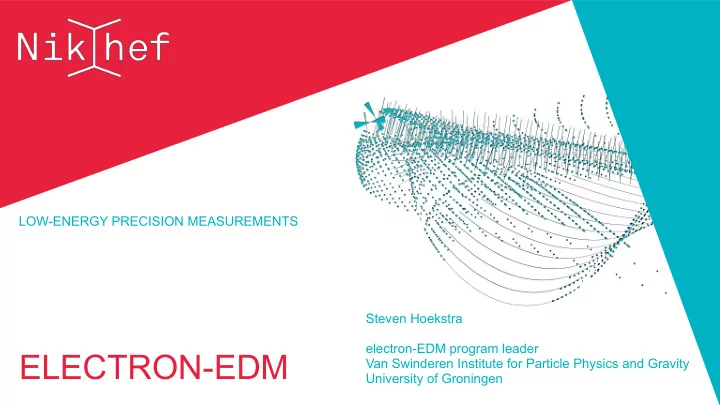

LOW-ENERGY PRECISION MEASUREMENTS Steven Hoekstra electron-EDM program leader ELECTRON-EDM Van Swinderen Institute for Particle Physics and Gravity University of Groningen
THE ELECTRON-EDM PROGRAM Low-energy precision measurements: • Key contribution of Van Swinderen Institute for Particle Physics and Gravity within Nikhef • University of Groningen joined Nikhef in 2016 Measuring the electron’s electric dipole moment (eEDM): • NWO funded program 2017-2023 • University of Groningen (RUG), Vrije Universiteit Amsterdam (VU) • 7 staff, 7 PhD students, 2 postdocs • Many master (1yr) and bachelor (3mo) students • Building on existing expertise and infrastructure F e - Ba � 2 Low-energy precision measurements: the electron-EDM program
THE TEAM ANNUAL MEETING SEPT 2018 F e - Ba � 3 Low-energy precision measurements: the electron-EDM program
THE ELECTRIC DIPOLE MOMENT Electron-EDM • EDM arises from T-violating interactions with heavy SPIN + particles in SM extensions • A clean probe for new physics • EDM heavily suppressed in the Standard Model • Current EDM sensitivity probes up to 30 TeV EDM • Multihiggs, supersymmetry, leptoquarks, … − F e - Ba � 4 Low-energy precision measurements: the electron-EDM program Low-energy precision measurements: the electron-EDM program
TABLE-TOP PARTICLE PHYSICS Exploit the extreme precision of atomic and molecular physics • We can measure mHz shift (10 -18 eV) of energy levels F B a Chose sensitive system and optimise techniques • Use the electron in a heavy polar molecule: BaF • 10 6 sensitivity enhancement through E-field inside polar molecule • Exploit long interaction times for increased sensitivity F e - Ba � 5 Low-energy precision measurements: the electron-EDM program
LONG INTERACTION TIME Principle of measurement: Ramsey interferometer • Create superposition state, accumulate phase difference, readout • Sensitivity to small energy shift scales with coherent interaction time • Therefore, use slow (30 m/s) and cold (100 K) beam of molecules μ Ramsey π /2 pulses Interference fringes 1 T 0 1 Increasing T 0 1 F π /2 pulse π /2 pulse 0 3 2 1 0 1 2 3 e - Ba � 6 Low-energy precision measurements: the electron-EDM program
OUR APPROACH Combine state-of-the-art techniques from AMO physics: • Cryogenic buffergas molecular beam source • Stark deceleration • Molecular laser cooling • Magnetic field shielding cryogenic source decelerator laser cooling state preparation interaction optical detection guide ~0.5 m ~4.5 m F e - Ba � 7 Low-energy precision measurements: the electron-EDM program
MOLECULE DECELERATOR F e - Ba � 8 Low-energy precision measurements: the electron-EDM program
CURRENT STATUS 150 M/S SrF MOLECULAR BEAM FLUORESCENCE 500 175 m/s 300 m/s 200 m/s CRYOGENIC MOLECULAR BEAM SOURCE OPERATIONAL 400 Photon counts 300 F I R S T S Stepper Motor 200 I Photo Multiplier G N Tube A BaF BEAM L Gas bottle (Ar + SF 6 ) Skimmer AND LASERS Valve 100 OPERATIONAL 12 13 14 15 16 17 18 19 Time of flight (ms) Ablation Laser (532 nm) F MOLECULE DECELERATOR Detection Laser (663 nm) OPERATIONAL e - Ba � 9 Low-energy precision measurements: the electron-EDM program
CURRENT STATUS Effective electric field in BaF 5 4 E eff (GV/cm) 3 2 1 0 0 10 20 30 40 50 Applied electric field (kV/cm) MAGNETIC SHIELDING EFFECTIVE ELECTRIC BAF MOLECULAR F DESIGN COMPLETED FIELD CALCULATED STRUCTURE INVESTIGATED e - Ba � 10 Low-energy precision measurements: the electron-EDM program
CONCLUSION Low-energy precision measurements • Searching for new physics through a measurement of the electron-EDM with cold molecules • Table-top particle physics with a potential for high impact • Research program on track, first publications coming out F F e - e - Ba Ba � 11 Low-energy precision measurements: the electron-EDM program Low-energy precision measurements: the electron-EDM program
Recommend
More recommend